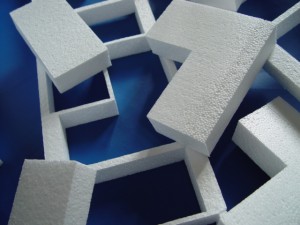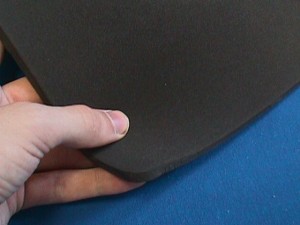From Planes, to Trains, to Automobiles: The Many Hobby Uses for Foam
Foam, in all of its varieties, is a material we typically use to get a job done. Whether insulating a home, stuffing a couch cushion, or managing sound with acoustical treatment, foam puts in long hours on the job, helping us perform better in ours.
But while foam will always be a valuable commodity for nine-to-five purposes, it also has recreational value that can make our free time more enjoyable. One of foam’s less-heralded uses is as a hobby medium, making modeling, scene and terrain building, and remote controlled racing even more fun.
As a toy nearly everyone has seen at some point in their lives, foam airplane gliders hold a soft spot in the hearts of many people. But while the experience ends with punch-out foam kits for most people, others never lose their love of flying and build their own planes that are capable of traveling hundreds of feet in a single trip.
The material used to accomplish most of these aeronautical achievements is polystyrene; a closed-cell foam most often seen as white foam coffee cups or building insulation. Polystyrene possesses two characteristics that help it excel as a great foam glider medium. The foremost is the material’s minimal weight, allowing it to glide through the air effortlessly. Most polystyrene foam used for crafting gliders is one or two pound density, which reflects the material’s weight in a 1 cubic foot block. Despite that lightness, polystyrene remains rigid and strong, giving the plane the form it needs to glide. The Foam Factory stocks 1LB, 2LB, and 3LB density polystyrene sheeting in many thicknesses, but only suggests their 1LB and 2LB densities for glider hobbyists. 2LB density offers greater durability than 1LB, but for beginners, experiments, and concepts, 1LB is more cost-effective.
Polystyrene’s other helpful craft foam quality is its formability. It is unique among foams, in that it isn’t able to be cut cleanly with traditional blades. However, using hot wire cutting tools made just for polystyrene, users have the ability to make cuts with more detail and smoother edges than is possible with traditional tools. These cutters allow curves and contours to be made for wings and fuselage that would be impossible to sculpt otherwise.
Another hobby which makes use of polystyrene is model railroading. The extent of some train layouts may be a loop around the Christmas tree during the holidays, but some railroading enthusiasts have cities and landscapes that take up entire rooms in their homes. Part of the fun of model railroading is creating your own world, and to add landscaping like mountainsides and hills, polystyrene is the perfect modeling material. These hobby foam forms can be created by gluing sheets together and carving them to shape with hand-held serrated blades. The flawless edges left by a hotwire cutter aren’t necessary, as you follow your cuts by sealing the foam with drywall joint compound, giving you a smooth surface that lets you easily paint foam.
Slot car racing is another hobby that benefits from foam. For racing setups placed in a carefully constructed setting, polystyrene can again be used as landscaping. But on performance-based tabletop tracks, another type of foam can benefit slot car hobbyists.
For these setups, the curves and bends in a track, coupled with the speed of the vehicles, may result in cars fishtailing or power sliding, mimicking real life performance and enhancing the experience. The problem this causes is that one lane of track may gain an advantage over the other, as most standard track does not accommodate the extra space high-speed movement requires. Many have bumper railings to keep cars on the track, but these give an advantage to the outside lane, as they can “ride the rails” at speeds greater than a track without rails would allow. However, no rails can allow the outside lane car to slide off the track and de-slot, giving an obvious advantage to the inside track. The solution to this problem is extending track width with a racing border using thin, closed-cell foam sheets.
Whether the scale of the track is large or small, hobbyists can add neoprene or cross-linked polyethylene (XLPE) foam inside and outside of curves, both foam varieties carried by The Foam Factory. The benefit of extending the track is that it permits cars to naturally drift without giving either lane an advantage. These closed-cell foams are desirable because they can be cut to match the height of the track for a smooth transition while offering traction. Made in dark charcoal colors, they blend in with tracks as well.
For permanent setups, hobbyists trim out strips and flex them around the track edge and either glue or tack down the foam. Racers who require more aggressive sliding space sometime create contoured tiles that fit along the track and may even lock into the existing track with minor modifications. Neoprene and XLPE can both be cut smoothly for straight or curved cuts with a sharp, non-serrated blade, and can even be sanded down for the perfect fit along the raceway.
These are only a few examples of how foam can used to have fun. As with anything, the only limitation to a material is creativity, so if you’ve found a great way to enjoy your hobbies and free time with foam, we’d love to hear how!
NOTE: We do not suggest using hotwire cutters on glued polystyrene forms. If a design requires multiple pieces of foam be bonded, cut the sheets individually, then bond them together and gently sand the seam with fine grit sandpaper.
Tags: Closed-Cell Foam, EPS, Hobby Foam, Neoprene, Polystyrene, XLPE
Posted in DIY




Leave a Reply